Issue, No.25 (March 2023)
Persistent segmentation in social policy in 21st century Latin America1
The expansion of social policy to outsiders in Latin American countries since the turn of the century has received a lot of attention from scholars and commentators. In this article, I highlight an equally important trend: the persistence or even increase in segmentation.
Introduction
The initial development of welfare policies in Latin America took place in the mid-twentieth century for a handful of “pioneer” countries following a conservative/corporatist model that linked benefits to employment. These Bismarckian foundations remain in place today, despite liberalization and privatization policies implemented during the 1980s and 1990s.
In the late 1990s and early 2000s, a wave of mass protests severely questioned the legitimacy of political regimes across South America and paved the way for a round of left or center-left governments–the so-called Pink Tide. Mass protests toppled governments in Argentina, Bolivia and Ecuador, and the widespread discontent with pro-market policies was felt across the region. Following this crisis of legitimacy, under strong popular pressure and benefiting from an extraordinary economic growth, pink tide governments implemented policies to address some of the most urgent social needs.
The expansion, however, was not exclusive of left-leaning governments. Most countries in Latin America improved their social protection systems, increasing coverage in different areas, such as transfers and healthcare. Conditional cash transfers (CCTs) were one of the principal policy tools governments used to provide economic relief to poor families. So-called non-contributory old-age pensions (NCPs) also expanded in many countries, substantially increasing the rate of people over retirement age receiving a modest, yet steady income.
The inclusion of previously excluded populations by new social policies implemented in the region has been widely documented. However, despite an emerging literature on the segmentation that these policies have also produced, this aspect has been much less studied.
Following Martinez Franzoni and Sánchez-Ancochea (2018), I use segmentation to describe the situation where “a significant amount of people are not sufficiently protected from market forces in a particular social policy realm … or when this protection is uneven among different groups”. Segmentation can be the result of a dual social policy regime, as in the liberal welfare regimes, where there is a private, high-quality service for those who can afford it, and a public, low-quality one for those who cannot. Segmentation can also be a consequence of stratification in many layers, as is common in corporatist-conservative (or Bismarckian, Christian-democratic) welfare regimes. We find both of these mechanisms (from the liberal and the corporatist policy designs) in Latin American countries, but I will focus here on the segmentation caused by the growth of the private provision in the past two decades.
The growth of the private sector, whether in healthcare or education, undermines any progress toward universalism. When higher- and middle-income people seek health or education in the private sector, it means public services are not good enough for them, whether it is because there are long waitlists or because it is of low quality. When higher- and middle-income people seek health or education in the private sector, the support for funding the public sector: these families no longer have a stake in improving it (Huber & Stephens, 2012, p. 43). Conversely, when access to healthcare is limited, or when quality depends on formal employment or the ability to pay, the quality of someone’s job, or their income, segmentation across different groups increases.
For this study, I collected data for the period 2000-2020 for 17 Latin American countries from a variety of sources2 to assess the evolution of social policy in four policy areas.
Results
Transfers
Conditional cash transfers (CCTs) have been one of Latin American governments’ favorite tools to provide relief to families in poverty and partially address income inequalities. CCTs are cash transfers to households living in poverty that meet certain criteria (usually, individuals must have children and be unemployed). Non-contributory old-age pensions have also spread significantly in the region, allowing millions of people in retirement age to have an income.
However, this expansion of coverage did not necessarily bring in the new beneficiaries to the already existing social policy schemes. Instead, the informal working class and the poor rural sectors were largely placed into a separate social protection network. In terms used by Armando Barrientos, in most cases they were not incorporated “horizontally,” into the already existing social insurance plans covering formal workers, but instead, “vertically”, into a separate layer of social assistance programs for the poor (Barrientos, 2019).
The number of CCT beneficiaries for the 17 countries analyzed in this study peaked at 160 million in 2014 and declined drastically after 2017. Similarly, by the mid-2010s close to 30 percent of the elderly were covered by non-contributory pensions (NCPs) (Arenas de Mesa, 2019). Non-contributory pensions are pensions for people above retirement age who are living in poverty and/or do not qualify for a contributory pension benefit.
As seen in Figure 1, inclusion rate among people above retirement age increased on average 25 percentage points between 2000 and 2019. While NCPs increased 19 percentage points in this period, the increase in beneficiaries of contributory pensions is much less pronounced, augmenting 8.5 points. This increase is less surprising if we consider that a growth of contributory pension beneficiaries is an expected trend accompanying the strong economic growth that started in 2002-2003.
Figure 1. Percentage of the population over retirement age receiving a pension. Unweighted average for 17 selected countries. 2000-2017
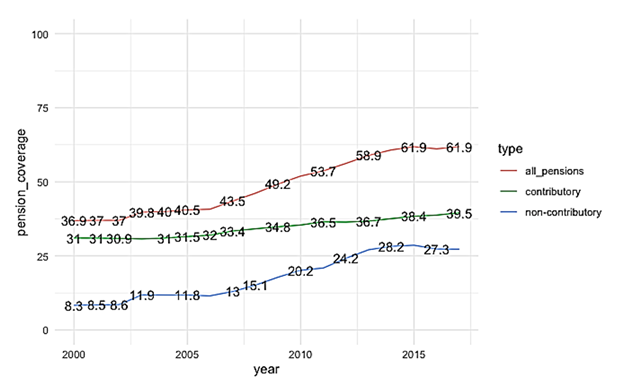
Source: data from Arenas de Mesa (2019).
In any case, the increase in the proportion of retired population receiving a pension is impressive. In contrast, the coverage rate for contributory pensions among working people has seen a significant but more modest, and uneven, increase. Argentina, Bolivia, Brazil, Colombia, Ecuador and Uruguay achieved important gains between 2002 and 2017, but other countries made modest progress or virtually none (such the cases of Guatemala and Honduras).
The divergence between the rapid increase in the–for the most part newly created–non-contributory pensions and the relatively more modest and uneven increase in the contributory pensions’ schemes points to the emergence of two distinct retirement pension systems. Because NCPs provide a lower benefit amount than contributory pensions (see Table 1), the result is an increase in segmentation.
Table 1. NCP benefit as percentage of average contributory pension benefit
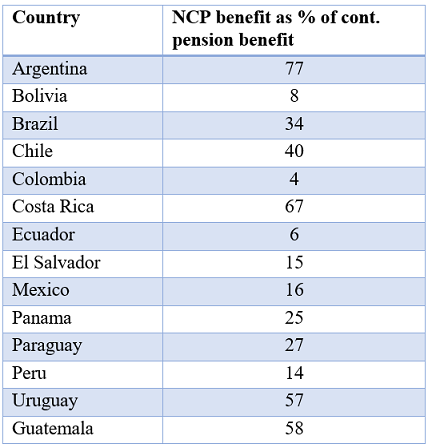
Source: data from (Rofman et al., 2015).
The number of people contributing to private pension funds (as percentage of the economically active population, EAP) continued to grow in most countries since 2000. All private pension schemes in Latin America are fully funded, defined-contribution, individual-capitalization systems. An increased weight of private pensions thus means greater segmentation, since individual capitalization accounts exacerbate the inequalities generated by the labor market. Argentina and Bolivia are two exceptions to this trend: both countries nationalized private pensions in 2008.
The expansion has come hand in hand with an increase in fragmentation. Across the board, a two-tier (or even a three-tier) pension system emerges, where social-assistance type, non-contributory pension programs are added to the already existing pension schemes based on social-insurance schemes, mandatory private pensions, or both. Kathleen Thelen has described coined the term “layering” to describe this policy strategy (Thelen, 2009). At the same time, the creation and expansion of two important means-tested transfer programs (NCP and CCT) implies an increase in social spending in the form of targeted social assistance, a feature that has been described as typical of liberal welfare regimes (Esping-Andersen, 1990).
Eduardo Gudynas has theorized the expansion in social assistance in this period as “compensatory” policies to buffer the negative consequences of capitalism and enhanced extractivism in the region. Taking as a point of departure the increased reliance on extractivism common to most countries in South America at the turn of the century, he proposes that “progressive governments” have protected and supported the dynamics of capitalism, promoted accumulation, and accepted the global governance of international trade. What made them different from the pro-market governments of the previous decades is that they enabled the state to capture some of the surplus and use it to “reduce some negative effects through the use of social assistance programs.” For this reason, he gives them the name of “compensatory state” (Gudynas, 2016).
Health and education
The trends in healthcare and education have been, on a superficial level, positive for the region. The number of school-aged-children enrolled in primary school remains close to 100 percent in most countries and drop-out rates fell across the board. Enrollment in secondary school increased.
However, when we take a closer look, a more sober picture appears. In many cases, there are signs of “policy drift” affecting these areas—i.e., increased demand is not met with the corresponding increment in government funding and resources, leading to deficits or low quality of services. As Figure 2 shows for primary school alone, the overall trend in the region has been that of a growing weight of the private sector. Chile stands out as a complete outlier, with levels of privatization roughly twice as high as the second highest. And even though the percentage of primary-school-aged children enrolled in private school is already above 40 percent in the year 2000, the figure increases steadily to reach above 60 percent in 2019. Argentina, Peru and Ecuador also show levels of primary school privatization above the average.
Figure 2. Enrollment in private education for primary school, Latin America 1990-2020, selected countries
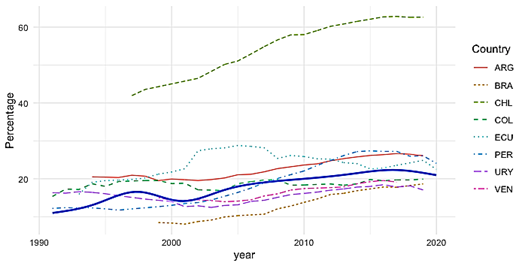
Source: World Bank. Thick blue line represents the unweighted average.
The healthcare sector in Latin America has been historically fragmented in three subsectors: a tax-financed public subsystem, a social insurance sector financed through payroll contributions (linked to formal employment), and individually-acquired private health insurance (Cotlear et al., 2015), and there has been little to no change to these fragmented structures since the turn of the century. WHO’s Universal Health Coverage indicator shows a sustained increase for all countries in this studied period. Similarly, public health spending has increased steadily in USD (a sign of both the economic growth in the region and the secular trend toward higher costs particular to the health sector) across the board, but there is wide variability among countries. Venezuela is the only exception, with declining spending when measured in USD in 2012 and 2017, probably as a consequence of the deep economic crisis in this country.
Public health spending as percentage of GDP increased in most countries, but there are some exceptions (Guatemala, Honduras, Panama and Venezuela) where the figure remained constant or decreased, and some countries where the increase has been relatively small (Peru, El Salvador and Costa Rica).3 (see Figure 3).
Figure 3. Public health spending as percentage of the GDP
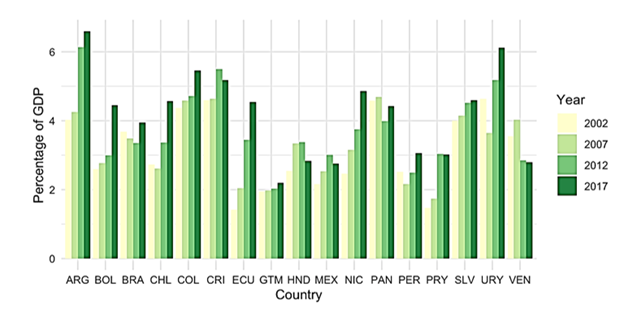
Source: World Bank.
For an accurate analysis of the level of segmentation in healthcare, we would need a reliable indicator of healthcare quality across different sectors of the population. But there is no such data available for most countries in the region. Indirect measures of commodification in healthcare can shed some light on this contested terrain. In almost all countries in the region for which data are available, out-of-pocket spending as a percentage of total health expenditure decreased. The same is true for private spending as percentage of current health spending. On the other hand, absolute levels of private spending and out-of-pocket spending increased (Figure 4).
This combination of a declining private spending as percentage of current spending, and an upward trend of indicators measuring roughly the amount of money spent in private health per capita reflects that: (1) there is an overall increase in public spending in health, which is, in proportion, larger than the increase in total health spending; and (2) the increase in public spending on health is not large enough to offset the absolute increase in private health spending–put differently, the additional public spending is smaller, in absolute terms, than the increase in total spending.
Figure 4. Three indicators of private health spending for 17 countries, 2000-2019
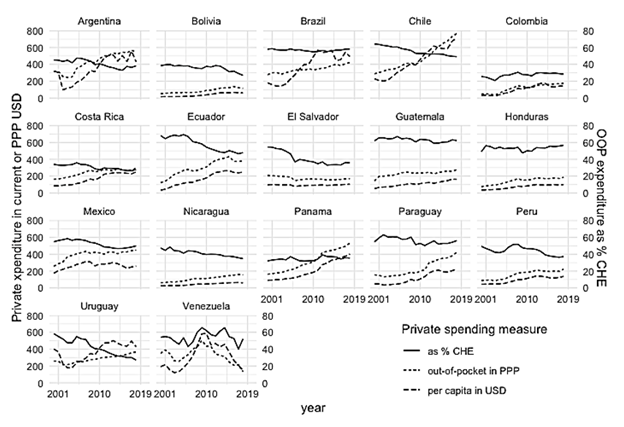
Source: World Bank. CHE: Current Health Expenditure.
Conclusions
There has been an important expansion in social policy to cover previously excluded sectors of the population. Although an increase in contributory and publicly-provided policies is observed, the predominant development is the rollout of new social assistance, targeted monetary programs (CCTs and NCPs).
Along with this, we observe an increased reliance on the market for the allocation and delivery of social services. The findings in this study show growing privatization of health and education, a tendency that nonetheless coexists with an increase in public health expenditure and an improvement in overall indicators for both health and education. Private pension funds increased in all countries except for the notable cases of Argentina and Bolivia, where mandatory private pension funds were nationalized. These trends reflect an increase in segmentation due to a higher dominance of market mechanisms for the distribution of social benefits.
Importantly, the fragmentation of social policy in areas like healthcare and pensions remains untouched. This fragmentation not only undermines the possibility of delivering equitable social services and benefits in the present moment, but it also precludes progress toward universalism in the long run. The addition of separate welfare schemes directed to specific groups of the population represents an obstacle in the path toward unification and equalization of benefits in the future.
The findings in this paper give support to Gudynas’s proposal of a compensatory state¬. This framework implies that the government did not obstruct the expansion of the market, and even encouraged capital investment, but only appropriated part of the surplus to fund social assistance programs to compensate for the unwanted effects of market penetration and increase extractivism. If the region has a chance at breaking the dependency on the sale of natural resources, the dual nature of welfare, and the high rates of exclusion, it will be through universalist policies, which will not only address many of these problems, but also strengthen working-class constituencies to defend their social rights and fight for more.
1 Based on Ferre, J. C. (2022). Social policy expansion and segmentation in the first two decades of the 21st century in Latin America. International Journal of Social Welfare, 1– 20. https://doi.org/10.1111/ijsw.12579
2 The Economic Commission for Latin America and the Caribbean (ECLAC, 2021), World Development Indicators (World Bank, 2021), Arenas de Mesa (2019), Rofman et al. (2015), Boletín AIOS Estadístico AIOS (AIOSFP, 2021), and UNESCO (UIS, 2020).
3 I use the World Bank indicator “Domestic general government health expenditure (% of GDP)”
References
| AIOSFP. (2021). Boletín Estadístico AIOS 2021. AIOSFP. retrieved from https://www.aiosfp.org/estadisticas/boletin-estadistico-aios.html |
| Arenas de Mesa, A. (2019). Los sistemas de pensiones en la encrucijada: Desafíos para la sostenibilidad en América Latina. CEPAL. |
| Barrientos, A. (2019). Social protection in Latin America: One region, two systems. In G. Cruz-Martínez (Ed.), Welfare and social protection in contemporary Latin America (pp. 59–71). Routledge. |
| Cotlear, D., Gómez-Dantés, O., Knaul, F., Atun, R., Barreto, I. C. H. C., Cetrángolo, O., Cueto, M., Francke, P., Frenz, P., Guerrero, R., Lozano, R., Marten, R., & Sáenz, R. (2015). Overcoming social segregation in health care in Latin America. The Lancet (British Edition), 385(9974), 1248–1259. https://doi.org/10.1016/S0140-6736(14)61647-0 |
| ECLAC. (2021). ECLAC Social and Economic Indicators Database. ECLAC. https://statistics.cepal.org/portal/cepalstat/dashboard.html |
| Esping-Andersen, G. (1990). The Three Worlds of Welfare Capitalism. Polity Press. |
| Gudynas, E. (2016). Natural resource nationalisms and the compensatory state in progressive South America. In P. A. Haslam & P. Heidrich, The political economy of natural resources and development (pp. 125–140). Routledge. |
| Huber, E., & Stephens, J. D. (2012). Democracy and the left: Social policy and inequality in Latin America. University of Chicago Press. |
| Martinez Franzoni, J., & Sanchez-Ancochea, D. (2018). Undoing segmentation? Latin American health care policy during the economic boom. Social Policy and Administration, 52(6), 1181–1200. |
| Ocampo, J. A., & Gómez-Arteaga, N. (2016). Social protection systems in Latin America: An assessment. In ILO Working Papers (No. 994902513402676; ILO Working Papers). International Labour Organization. |
| Rofman, R. P., Apella, I., & Vezza, E. (2015). Beyond contributory pensions: Fourteen experiences with coverage expansion in Latin America. World Bank Group. |
| Thelen, K. (2009). Institutional Change in Advanced Political Economies. British Journal of Industrial Relations, 47(3), 471–498. https://doi.org/10.1111/j.1467-8543.2009.00746.x |
| UIS. (2020). UNESCO Institute for Statistics database. UNESCO.http://data.uis.unesco.org/ |
| World Bank. (2021). World Development Indicators. World Bank. https://databank.worldbank.org/source/world-development-indicators |
